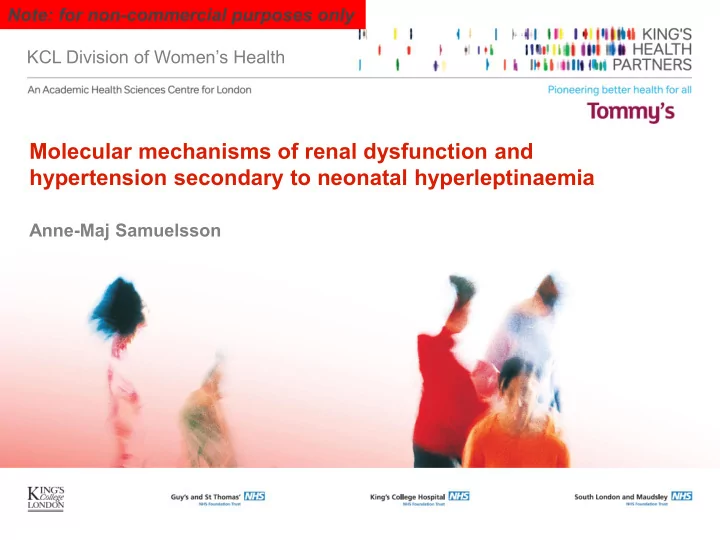

Note: for non-commercial purposes only KCL Division of Women’s Health Molecular mechanisms of renal dysfunction and hypertension secondary to neonatal hyperleptinaemia Anne-Maj Samuelsson
Maternal obesity imprint cardiovascular, renal and metabolic dysfunction in the offspring Sympathetic nervous Maternal Causes Fetal Causes system activation Physiopathologicalogical mechanism Hyperinsulinaemia Baroreflex impairment Renin-angiotensin system Renal afferent nerve activation Adipokine activation Endothelial dysregulation (leptin↑) dysfunction Nephrogenesis Psychological stress Nephron hyperfiltration Inflammation Oxidative stress Oxidative stress Inflammation EARLY ORIGIN OF HYPERTENSION/ RENAL DYSFUNCTION
Maternal Obesity and Neonatal Leptin Origin of SNA mediated hypertension A. Neonatal leptin surge Early Onset Hypertension NEONATAL LEPTIN Sympathetic Overactivity Hyperphagia Cardiac Dysfunction B. ARC pSTAT3 Renal Function? 2 3000 ir Cells/mm 2500 - - * * 2000 Number of pSTAT3 1500 1000 500 0 - - 2.30 - 2.30 - 3.30 - 3.30 - 4.16 4.16 Bregma (mm) Bregma (mm) OffCon OffOb Kirk et al 2009, PlosOne, Samuelsson et al 2013, Hypertension 14 * 12 10 Delta MAP mmHg) 8 6 4 2 0 OffCon OffOb
Renal dysfunction in animal models Maternal UN/GDM- Reduced nephron number, increased Na reabsorption, activation of RAS and oxidative stress Maternal HF diet -Salt-induced hypertension, Na-ATPase activity, no serological evidence Renal proximal tubule Na+ reabsorption extracellular volume BP -Na-ATPase -Na + /H + exchanger isoform 3 (NHE3)-PT -Na + -K + -Cl- cotransporter (NKCC2a and b) –TAL Regulation of sodium homeostasis -Reactive oxygen species (ROS) -Ang II -Cyclo-oxygenase 2 (COX2) -RSNA High RSNA Kidney ischemia Intrarenal RAS Hyperfiltration Renal disease (Merlet-Benichou C et al 1994)(Jones SE et al 2001)(Gilbert JS et al 2005)(Armitage 2005) (Rudyk et al 2000)
Aim To investigate if exposure to elevated leptin in early postnatal life may permanently influence renal function due to altered renal sympathetic nerve activation, oxidative status, and renal vascular smooth muscle responses
Study Design Sprague-Dawley rats C57Bl/6 mice F0 F0 F1 F1 (PD9-PD14 ) (PD9-PD15 ) Neonatal saline Neonatal leptin Neonatal saline Neonatal leptin (S-Tx) (3μg/g, L-Tx) (S-Tx) (3μg/g, L-Tx) F1 Telemetry surgery F1 Telemetry surgery (1-2 month) Renal Denervation (RD and SH) (6 month) Renal Function Renal Function before and after RD Renal QPCR Renal Myography F1 Renal Function (6 month) Salt loading
Hypertension-Unilateral Renal Denervation Renal Denervation 1 month old male rats 120 120 ** MAP (mmHg) 110 110 MAP (mmHg) 100 100 90 90 S-Tx S-Tx SH L-Tx S-Tx RD 80 80 0 5 10 15 20 25 0 5 10 15 20 25 Time (min) Time (hours) 6 month old male mice *** 130 S-Tx 140 L-Tx ** * 120 MAP (mmHg) MAP (mmHg) 130 110 120 100 110 L-Tx RD 100 90 L-Tx SH 90 80 0 5 10 15 20 25 0 5 10 15 20 25 Time (Hours) Time (hours) *P<0.001, **P<0.01, *P<0.05 (repeated ANOVA t test). Data are presented as mean ± SEM; n=4-8 per group.
Renal Artery Myography in the early-hypertensive phase (1 month old) pEC 50 Noradrenaline Renal Denervation L-Tx-SH, 6.0±0.1 pEC 50 2.0 2.0 L-Tx-RD, 5.6±0.1, P<0.05 L-Tx, 5.8±0.1 S-Tx. 5.4±0.1,P<0.05 Tension (mN/mm) 1.5 ECmax Tension (mN/mm) 1.5 L-Tx-SH, 1.8±0.1 ECmax 1.0 L-Tx-RD, 1.2±0.1,P<0.05 L-Tx, 1.7±0.1 1.0 S-Tx,1.1±0.1, P<0.01 0.5 L-Tx-SH 0.5 L-Tx L-Tx-RD 0.0 S-Tx 0.0 -8 -7 -6 -5 -0.5 -9 -8 -7 -6 -5 NA log [M] -0.5 NA log [M] Sodium nitropruisside pIC 50 pIC 50 L-Tx-SH, 6.3±0.1 L-Tx, 6.2±0.1 100 L-Tx-RD. 6.4±0.1,ns 100 S-Tx. 6.4±0.1,ns ICmax Relaxation (%) Relaxation (%) ICmax 75 75 L-Tx-SH, 48±3 L-Tx, 49±9 L-Tx-RD, 62±2, P<0.05 S-Tx, 67±6, P<0.01 50 50 L-Tx-SH 25 25 L-Tx L-Tx-RD S-Tx 0 0 -10 -9 -8 -7 -6 -5 -4 -3 -10 -9 -8 -7 -6 -5 -4 -3 SNP log [M] SNP log [M] Data are presented as mean ± SEM; n=4-8 per group, t-test.
Renal Function and Salt Challenge Water intake (ml/24) * 60 50 Urine volume (ml/24h) S-Tx ** S-Tx * L-Tx L-Tx 40 * 40 30 * 20 20 * 10 0 0 50 S-Tx * S-Tx L-Tx 3 Albuminuria (mg/ml) L-Tx 40 Creatinine Clearance (ul/min/100gBW) * 30 2 * 20 * 1 10 * * 0 0 Data are presented as mean ± SEM; n=4-8 per group,*P<0.05, t-test.
Intrarenal expression of RAS, oxidative stress component and sodium transporters at established-hypertension phase Renin Angiotensin system Oxidative stress and Fibrosis * 2000 Normalised mRNA ** 2500 S-Tx 200 S-Tx ** 150 L-Tx Normalised mRNA L-Tx Normalised mRNA 2000 1500 100 ** 50 * 1500 0 * 1000 * 1000 * ** 500 ** * 500 ** 0 0 Na/H and Na/K/Cl cotransporters * 15000 Normalised mRNA S-Tx L-Tx 10000 5000 0 Data are means±SEM. N=5-6. **p<0.01,*p<0.05 vs S-Tx using t-test
CONCLUSION Neonatal leptin treatment (L-TX) led to Hypertension MAP before obesity. Enhanced contractile response in 2 nd order renal arteries Renal nerve denervation of left kidney showed beneficial effects (normalised the blood pressure and artery function) illustrating the important role of renal sympathetic overactivity in this model Renal parameters during early hypertensive phase (1 month) showed decreased creatinine clearance. L-Tx rats had significant albuminuria which was totally suppressed by renal denervation. The renal physiology during established hypertension phase (6 months) showed significant decrease in creatinine clearance, accompanied by an expanded plasma volume and urine albuminuria.
CONCLUSION II Neonatal leptin treatment (L-TX) led to Altered renal RAS, sodium transport and oxidative stress markers during established-hypertension phase Increased renal RAS, Cox-2 and Nox-4 may affect renal microvasculature and Na + sodium reabsorption via Na + ATPase contributing further to the permanent hypertensive state.
Thanks to Page 12 King’s College London Katharina Tilgner Shona Kirk Joaquim Pombo Vanessa Alderman Sarah Wylie Dr Paul Taylor Prof Clive Coen Prof Lucilla Poston
Recommend
More recommend